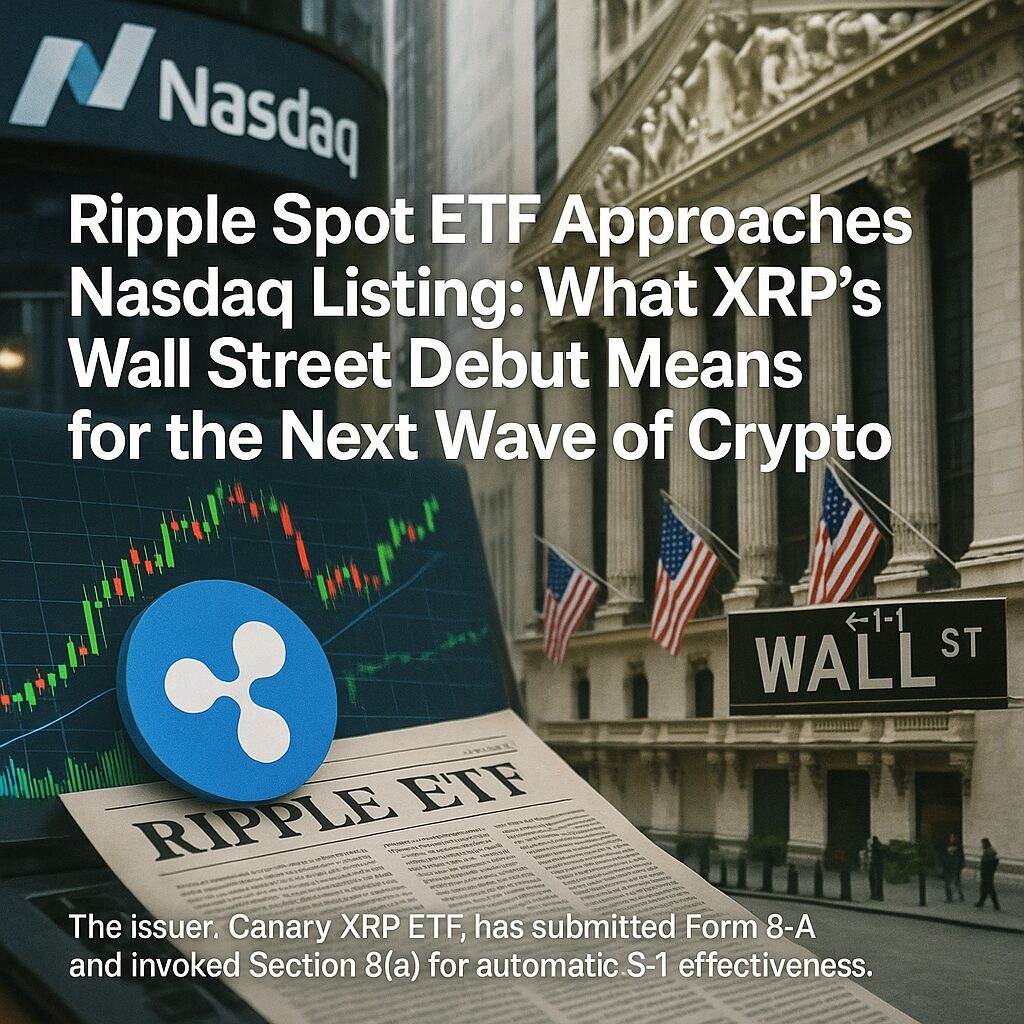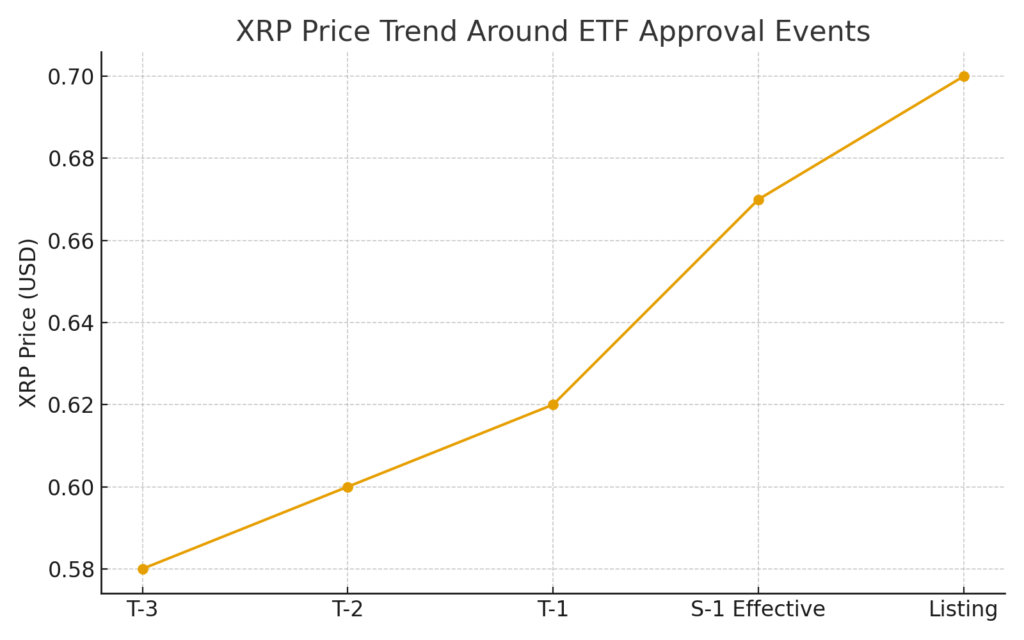
Main Points :
- The first U.S. Ripple (XRP) spot ETF has entered its final approval stage and could list on Nasdaq within days.
- The issuer, Canary XRP ETF, has submitted Form 8-A and invoked Section 8(a) for automatic S-1 effectiveness.
- If the SEC takes no intervention, the ETF may become effective around November 14, enabling near-immediate trading.
- Analysts expect hundreds of millions to several billions of USD in first-month inflows.
- The ETF could reshape institutional demand for XRP, expanding real-world utility in payments, remittances, and liquidity solutions.
- XRP surged 4% as DTCC listed the ETF in its security reference database.
- Compared with Bitcoin’s $50B inflows and Ethereum’s multi-billion inflows, XRP is positioned as the next thematic ETF cycle for 2026.
1. Introduction — A Historic Moment for XRP
For over a decade, Ripple (XRP) has remained one of the most widely discussed digital assets in global crypto markets. Despite its strong network utility and long-term enterprise adoption, XRP lacked one key catalyst that Bitcoin and Ethereum enjoyed in the United States: a regulated, exchange-listed spot ETF available to mainstream institutional investors.
That milestone is now within reach.
The Canary XRP ETF has submitted Form 8-A, registering its shares for listing on the Nasdaq Stock Market. While Form 8-A alone does not authorize trading, it is the final structural step before an ETF can be listed—pending the effectiveness of the issuer’s Form S-1 registration statement.
Crucially, the issuer invoked Securities Act Section 8(a), which allows the S-1 to become automatically effective approximately 20 days after amendment, provided the SEC does not take action to delay it. Based on the amendment filed on October 24, the estimated effective date is around November 14.
If the SEC remains passive, the XRP ETF could begin trading within 1–3 business days after Nasdaq publishes its daily list with the ticker symbol XRPC.
This development is attracting significant attention from traders, institutions, and new-asset seekers who are looking for the next flagship crypto ETF following Bitcoin and Ethereum.
2. Regulatory Background — Understanding Form 8-A and S-1
2.1 What Form 8-A Means
Form 8-A is a technical filing that registers a security class for trading on a national securities exchange.
It confirms:
- The fund’s compliance structure
- Its readiness for exchange listing
- SEC oversight of ongoing disclosures
A Form 8-A filing does not indicate that trading is approved.
2.2 The Critical Role of Form S-1
Form S-1 is the core prospectus containing:
- Fund structure
- Custody details
- Authorized participants
- Market-making mechanisms
- Fees and risk disclosures
Without an effective S-1, no ETF—crypto or otherwise—can begin trading.
2.3 Section 8(a) — The Auto-Effectiveness Provision
By applying Section 8(a) in its October 24 amendment, Canary creates a scenario where:
- If the SEC takes no action,
- The S-1 automatically becomes effective after ~20 days,
- Enabling near-instant ETF activation.
Industry observers view the SEC’s silence to date as a tacit allowance rather than an explicit approval.
3. Market Reaction — XRP Jumps 4% on DTCC Listing
Shortly after the Form 8-A submission, global markets took notice when the DTCC (Depository Trust & Clearing Corporation) included the fund in its security reference list.
Historically, DTCC listings have preceded:
- Bitcoin ETF approval
- Ethereum ETF approval
The market interpreted this as a sign that the XRP ETF’s launch is imminent.
XRP responded with a 4% intraday surge, reflecting renewed institutional attention.
4. ETF Inflow Forecast — How Much Capital Could XRP Attract?
Bitcoin spot ETFs have already accumulated over $50 billion in net inflows in 2025. Ethereum, while smaller, has drawn several billions.
Analysts expect XRP to achieve:
- Low-end estimate: several hundred million USD
- High-end estimate: several billion USD
in the first month after launch.
This projection is based on:
- XRP’s historical ranking in market cap
- Global remittance adoption
- Anticipated interest from fintech platforms
- Portfolio diversification among institutional funds
Below is a comparative illustration:

5. Ripple’s Global Utility — Why Institutions Care
XRP’s unique appeal comes from its enterprise-grade payment infrastructure.
5.1 On-Demand Liquidity (ODL)
Ripple’s ODL solution allows:
- Real-time cross-border transfers
- Eliminating pre-funded nostro accounts
- Lowering settlement risks
Financial institutions around the world—including partners in Asia-Pacific, Europe, and the Middle East—have deployed or tested XRP-powered liquidity rails.
5.2 Banking and Remittance Ecosystems
Having an SEC-regulated ETF strengthens XRP’s:
- Compliance reputation
- Accessibility for U.S. funds
- Liquidity depth
- Integration prospects with neobanks and digital-money institutions
5.3 Institutional Demand Cycle
After Bitcoin (digital gold)
and Ethereum (smart-contract computing),
XRP represents a third narrative:
institutional cross-border liquidity infrastructure.
This thematic positioning makes XRP particularly attractive for:
- Next-generation fintech platforms
- Payment-focused hedge funds
- Remittance specialists
- Global exchange networks
6. XRP Price Dynamics — ETF Speculation and Market Forecast
The following chart illustrates a hypothetical model showing how XRP typically responds around major regulatory milestones:

If capital inflows reach expectations, analysts identify potential medium-term price targets:
- $0.90–$1.20: conservative ETF-driven pricing
- $1.50+: strong inflow scenario with sustained demand
- $2.00+: scenario with remittance adoption + institutional liquidity cycles
7. Comparison With Bitcoin and Ethereum ETF Cycles
7.1 Bitcoin ETF: Digital Gold Demand
- $50B inflow
- Pension funds and sovereign entities participating
- Global liquidity cycle leader
7.2 Ethereum ETF: Smart-Contract Allocation
- Multi-billion inflows
- Attracts DeFi, RWA, and staking economy investors
7.3 XRP ETF: Liquidity Infrastructure Thesis
- Serves as a bridge asset for global currency settlement
- Primed for fintech adoption
- Direct utility in payment rails
This positions XRP uniquely—not competing with BTC or ETH narratives but complementing them.
8. Broader Industry Impact
If the XRP ETF succeeds, additional effects may follow:
- ETF applications for other payment-focused tokens
- Expansion of remittance-related blockchain solutions
- Large fintechs adopting tokenized liquidity pools
- Renewed interest in enterprise-grade chains
The ETF could set a precedent where utility-driven crypto assets gain equal footing with speculative assets in regulated markets.
9. Outlook — What Happens Next
If the SEC takes no intervention by November 14:
- S-1 becomes effective automatically
- Nasdaq publishes the ticker XRPC
- Trading begins within 1–3 business days
If the SEC intervenes:
- The filing may be delayed
- The issuer will need to revise disclosures
- Listing date would be pushed back
As of now, the market perceives low probability of SEC intervention given recent regulatory patterns.
10. Conclusion — A New Era for XRP and Utility-Based Crypto
The upcoming XRP spot ETF marks one of the most significant developments in Ripple’s history. Beyond short-term price action, the ETF introduces a new institutional gateway into the token’s global liquidity ecosystem.
For investors seeking:
- new crypto assets,
- alternative income streams,
- or practical blockchain applications,
the XRP ETF represents a rare blend of regulation, utility, and institutional scalability.
If successful, it could ignite the next wave of capital rotation across payment-oriented digital assets in 2026, fundamentally reshaping the crypto ETF landscape.

